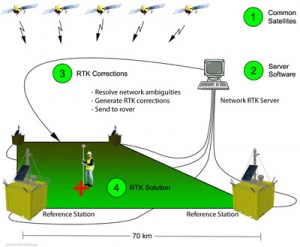If you wish to contribute or participate in the discussions about articles you are invited to contact the Editor
RTK Systems
| Fundamentals | |
|---|---|
| Title | RTK Systems |
| Author(s) | See the Credits section |
| Level | Basic |
| Year of Publication | 2011 |
There are DGNSS techniques used by high-precision navigation/surveying applications, based on the use of carrier phase measurements. This is the case of the Real Time Kinematics (RTK), where the differential GNSS measurements are computed in real-time by specific GNSS receivers if they receive a correction signal using a separate radio receiver. When referring to GPS in particular, the system is also commonly referred to as Carrier-Phase Enhancement, CPGPS.[1]
When using RTK dual-frequency systems the rover position accuracy is typically 1 centimeter ± 2 ppm (horizontal) and 2 centimeters ± 2 ppm (vertical) [2]. As it was seen in article RTK Fundamentals, this accuracy decreases if ambiguity resolution is not correctely solved, and this happens due to error decorrelation that increases proportionately with baseline distance. This decorrelation error can be of the order of one meter, contrary to other error sources ( atmospheric effects, multipath, orbit errors, or noise) that are of the order of several millimeters up to a few centimeters [2]. To solve this issue, around 2004 the Network RTK Systems were developed, mainly in areas of great GPS surveying activity.
RTK Systems
When the RTK systems began to operate (around 2000), they used a single base station receiver and a number of mobile units. The base station re-broadcasts the phase of the carrier that it measured, and the mobile units compare their own phase measurements with the ones received from the base station,[1] following the RTK Standards. This allows the mobile units to calculate their relative position to millimeters, although their absolute position is accurate only to the same accuracy as the position of the base station.[1]
When referring to RTK technique, the key is the "Ambiguity Resolution". Once ambiguity is fixed by LAMBDA Method, the problem of RTK Systems is that accuracy and realibility is degraded when one single base station is in a distance larger than a few tens of kms. To overcome this problem, the Network RTK Systems have been used over the last years.[3]
This Network RTK Systems have had a great success in areas with a lot of GPS surveying activity, such as Europe. In these areas there are many permanent reference stations, allowing to users to share infrastructure and costs. [3]
According to H-J Euler:[3]
The integration of several reference stations into a combined network provides benefits for the user by improving the accuracy and increasing the overall user system performance. For the reference station operator, networking reduces the number of stations that are needed to provide a given level of accuracy to the rover users. These permanent reference station networks are requiring real-time communication to a networking computation center and real-time estimation of biases between reference stations.
The way of distributing the information generated in the computing center to the user in the field is a very important question, because having the capability to supply the RTK service for a lot of types of rover equipment is essential to service providers. Therefore, the supplied information by the network computation centers and the way of processing the data must be completely understood. Nowadays, the infomation is supplied in two ways:
- the FKP-approach (FKP stands for the German word of spatial correction parameter)[4], property of Geo++
- Virtual Reference Station (VRS) approach, property of Trimble.
As it is noted in H-J Euler:[3] Both approaches deliver observations that are supposed to be operational with modern RTK equipment. However, as noted above, the ways the computational algorithms running at the networking computation center are proprietary. Optimal interoperability is not guaranteed, since the definition and an interface mechanism is missing. While the roving user equipment might work optimally with one vendor's networking software providing a service, it might have degraded performance with another vendor's software.
According to Trimble, VRS is the network solution used in more than 95% of the installations.[5]
Credits
This article has been edited by GMV, including and adapting text from the following sources, as indicated with the corresponding references:
- RTK in Wikipedia[1], provided under Creative Commons Attribution-ShareAlike License
- Real-Time Kinematic in the Light of GPS Modernization and Galileo, by Bernd Eissfeller et al.[2]
- Reference Station Network Information Distribution, by Hans-Jürgen Euler[3]
Notes
References
- ^ a b c d RTK in Wikipedia
- ^ a b c Bernd Eissfeller, Thomas Pany, Günter Heinrichs, Christian Tiberius, Real-Time Kinematic in the Light of GPS Modernization and Galileo, Oct. 1, 2002, GPS Word
- ^ a b c d e Reference Station Network Information Distribution, by Hans-Jürgen Euler, IAG Working Group 4.5.1: Network RTK (2003-2007)
- ^ On the modelling of GNSS observations for high−precision position determination, Gerhard Wübbena, Translation of Wübbena, G. (2001). Zur Modellierung von GNSS−Beobachtungen für die hochgenaue Positionsbestimmung. Wissenschaftliche Arbeiten Fachrichtung Vermessungswesen an der Universität Hannover, Festschrift Prof. G. Seeber zum 60. Geburtstag, Nr. 239, Hannover, 143−155.
- ^ Support of Network Formats by Trimble GPSNet Network RTK Solution, Trimble, 2005

